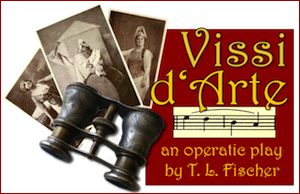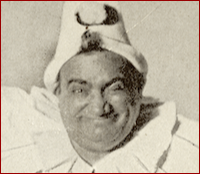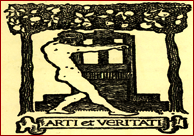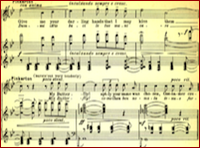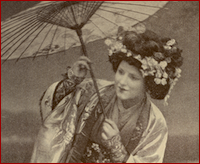
The History Behind the Play
“We must share something with them, Enrico. We must make them understand that we were once alive. That our hearts filled to bursting with love and desire, and our thoughts raced with hopes and dreams. And that we sang the most beautiful music the world has ever known.”
Ghost Frances, Act I, Scene 1
The main characters and events in Vissi d’Arte are based on real opera personalities and historical situations. Here and there during the play, the ghost narrators give brief historical updates to remind us what else was happening in the world at that time.
The Conductor and the Diva
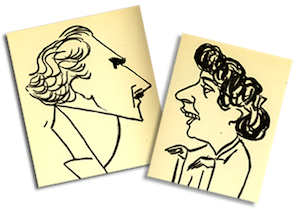
Pictured: caricatures by Enrico Caruso of Toscanini, capturing the conductor’s renowned intensity, and the tenor’s rather unflattering sketch of soprano Farrar.
The Dour Theater Manager and the Vivacious Soprano
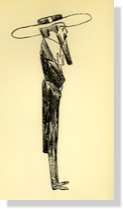
Pictured: Enrico Caruso’s caricature of Giulio Gatti-Casazza.
The World’s Greatest Tenor
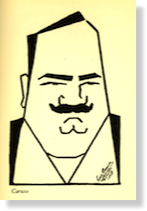
Pictured: Enrico Caruso’s self-caricature.
Other Historical Notes
• In November 1906, Enrico Caruso was arrested for making “improper” advances to a woman named Hannah Stanhope in the Monkey House at the Central Park Zoo in New York City. Comically represented in Act I, Scene 2.
• Caruso did find himself in court more than once for breaching promises to marry. But it appears that he found true love with American Dorothy Park Benjamin. They were married on August 20, 1918.
• Geraldine Farrar’s fame was second only to Caruso’s when Cecil B. DeMille directed her in the silent film version of Carmen. Back onstage in early 1916, she adopted the more histrionic style of silent-movie acting to several of her performances as Carmen. Once Farrar went so far as to bite Caruso—an interpretation the tenor neither expected nor appreciated. This episode is represented in Act III, Scene 2.
• Abandoned by her lover of seven years—conductor Arturo Toscanini—Farrar returned from Hollywood in 1915 married to movie star Lou Tellegen. Though forgotten now, in those days Tellegen was famous.
• The Knickerbocker Hotel was not only the home of Caruso and his entourage, as well as that of baritone Antonio Scotti, it was also a gathering place for lunch for many of the opera personalities represented in Vissi d’Arte.
• When war broke out in August of 1914, many of the great opera personalities of the time were in Europe. By late autumn, getting out of Europe wasn’t so easy. But the steamship Canopic would become known as “Opera’s Noah’s Ark” when Enrico Caruso, Geraldine Farrar, Antonio Scotti, conductor Arturo Toscanini, and theater manager Giulio Gatti-Casazza, among others, made their way from various points on the continent to return to North America. The Canopic passage is represented in Act II, Scene I.
• World War I had been raging for over three years before the USA joined the fight. After the American Congress declared war on the German Empire in 1917, though, anti-German sentiment rose to fever pitch. German opera singers in New York City lost their jobs, and Wagner’s music lost its place in the repertoire.
• Caruso did find himself in court more than once for breaching promises to marry. But it appears that he found true love with American Dorothy Park Benjamin. They were married on August 20, 1918.
• Geraldine Farrar’s fame was second only to Caruso’s when Cecil B. DeMille directed her in the silent film version of Carmen. Back onstage in early 1916, she adopted the more histrionic style of silent-movie acting to several of her performances as Carmen. Once Farrar went so far as to bite Caruso—an interpretation the tenor neither expected nor appreciated. This episode is represented in Act III, Scene 2.
• Abandoned by her lover of seven years—conductor Arturo Toscanini—Farrar returned from Hollywood in 1915 married to movie star Lou Tellegen. Though forgotten now, in those days Tellegen was famous.
• The Knickerbocker Hotel was not only the home of Caruso and his entourage, as well as that of baritone Antonio Scotti, it was also a gathering place for lunch for many of the opera personalities represented in Vissi d’Arte.
• When war broke out in August of 1914, many of the great opera personalities of the time were in Europe. By late autumn, getting out of Europe wasn’t so easy. But the steamship Canopic would become known as “Opera’s Noah’s Ark” when Enrico Caruso, Geraldine Farrar, Antonio Scotti, conductor Arturo Toscanini, and theater manager Giulio Gatti-Casazza, among others, made their way from various points on the continent to return to North America. The Canopic passage is represented in Act II, Scene I.
• World War I had been raging for over three years before the USA joined the fight. After the American Congress declared war on the German Empire in 1917, though, anti-German sentiment rose to fever pitch. German opera singers in New York City lost their jobs, and Wagner’s music lost its place in the repertoire.
Vissi d’Arte is on file with the United States Copyright Office; the registration number is PAu2-909-657. All rights are reserved to the copyright holder(s) or their assignees.
The images above are licensed stock images, images from the public domain, images owned by T.L. Fischer, or combinations of such, meant for illustrating the themes or simply the feel of the advertised writings. Use without permission or appropriate licensing is strictly prohibited.

